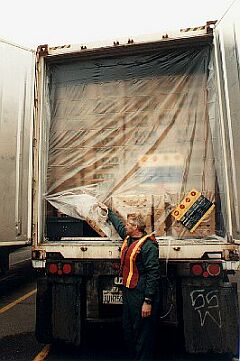The main reasons for the success of CA for relatively cheap mass products such as bananas are increased plantation production (the fruit can stay longer on the stalk, thus increasing in weight), reduced waste (on a refrigerated cargo ship with a load weighing 8,000 metric tons, a single percent waste equates to 80,000 kg) and higher product quality. The fact that marketing of these products from cultivation, through transportation right up to point of sale are in the hands of a single company, means that the benefits arising from CA, that despite everything are only in the region of a few percent, can actually be realized. If this were not the case, however, savings of this magnitude would soon be eaten up by the margins in the chain.
It is estimated that around 20 - 30% of cargo transported in refrigerated cargo ships is now transported under CA conditions. This technology is, therefore, already established in this area.
For containers, the situation has until now been different because a different kind of technology has been employed. As a proportion of the overall number of refrigerated containers transported (approx. 1.2 million per year), the number of transportations under CA conditions (around 48,000 to 54,000) represent only around 4 - 4.5% (figures for 2000).
 |
The large majority of these are also carried out by fruit companies, which transport their bananas in containers in particular to North America, but which also transport containers on the decks of refrigerated cargo ships. They generally use centralized systems for supplying nitrogen to the containers. Often, these systems are already in place on refrigerated cargo ships to supply the hold with nitrogen, but on dedicated container ships, special systems must be installed. It is estimated that around 38,000 to 42,000 FEU CA cargos are shipped every year with central CA systems such as this. Active CA containers so far represent the smallest share of CA transport operations in containers. These containers have an in-built nitrogen separator and can establish the correct atmosphere autonomously. Around 1,800 to 2,000 of these containers are in use across the globe, and they make an estimated 4,000 - 5,000 CA journeys a year. The passive CA system is relatively widespread. This demands that the containers are filled with the initial atmosphere at the port of loading. |
| Figure 57: Container with a curtain in the doorway to increase gastightness |
This atmosphere is then sustained during transportation by the targeted addition of fresh air and removal of CO2. The main advantage of this system is that the necessary costs of modifying the containers are very low. Thus, around 45,000 containers globally have been modified for this system (all figures for 1999). This corresponds to around 10% of all refrigerated containers. Around 8,000 to 9,000 CA shipments are carried out annually with this system, primarily avocados, stone fruits, asparagus and broccoli. Almost all new refrigeration units are suitable for this system.